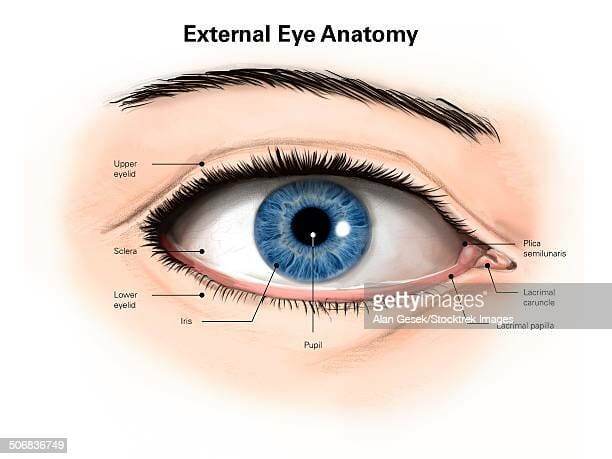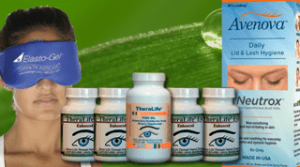Causes of dry eyes, treatment, and symptoms
Causes of Dry eyes are when the tears are too thin.
This can cause eye problems.
Symptoms may occur as pain in eyes or headaches resulting from blurred vision or light-sensitivity.
Dry eyes can last between mild and severe.
Mild cases may require OTC therapy while serious cases may require prescription medications.
In rare cases the need for surgical treatment may arise.
Changed lifestyles can help treat or manage the conditions that occur.
What are the causes of dry eyes?
There are a variety of reasons for causes of dry eyes.
Dry eye is a condition that occurs when tears cannot properly lubricate the eyes.
Causes of dry eyes by either a decrease in tear creation or an increase in tear evaporation.
If not treated, dry eye can cause lasting damage to the corneal surface and declining vision.
Several factors can be the causes of dry eyes.
- Evaporation of water from the tear film can increase due to blepharitis /meibomian gland dysfunction .
- “Blepharitis/meibomian gland dysfunction causes decreased production or altered composition of oil and is a common condition associated with rosacea.
- Demodex mites,
- Graft versus host disease and other conditions.
What is Tear?
Tears are a combination of: Water, for moisture Oils, for lubrication and to prevent evaporation of tear liquid Mucus, for even spreading of tears on the surface of the eye.
Antibodies and special proteins, for resistance to infection.
These components are secreted by special glands located around the eye.
It makes the tear surface smooth and keeps tears from drying up too quickly.
This layer is made in the eye’s meibomian glands.
When there is an imbalance or deficiency in this tear system, or when the tears evaporate too quickly, a person may experience dry eye.
When tears do not lubricate.
Reflux Tears
When foreign bodies irritates your eye – it sends a distress signal through your nervous system for more lubrication.
Your body sends a flood of tears to try to make up for the dryness.
It’s a lot like what happens when you get sand in your eye and it runs.
But these tears are mostly water, so they don’t act like normal tears.
They can wash debris away, but they can’t coat your eye’s surface.
Tears provide lubrication,
- reduce the risk of eye infection,
- wash away foreign matter in the eye and
- keep the surface of the eyes smooth and clear.
Excess tears in the eyes flow into small drainage ducts in the inner corners of the eyelids, which drain into the back of the nose.
Factors that Affect Tear film
Aging
Tear production tends to diminish with age, with various medical conditions or as a side effect of certain medicines.
Environment
Environmental conditions, such as wind and dry climates, can also decrease tear volume due to increased tear evaporation. When the normal amount of tear production decreases or tears evaporate too quickly from the eyes, symptoms of dry eye can develop. Poor quality of tears. Tears are made up of three layers: oil, water, and mucus. Each component protects and nourishes the front surface of the eye.
Blepharitis/MGD
A blepharitis / meibomian stomatosis can cause increased water in tear films. “Blepharitis /meibiomyosis resulting from oil production decreases or affects the composition of the racial groups rosacea and mites.
autoimmune diseases
The disease can also occur by graft against host diseases,” Akai said. Decreased tear production can be caused due to autoimmune or inflammatory systems such as sarcoidosis or Lupus.
Medications
Certain medicines, including antihistamines, decongestants, blood pressure medications, and antidepressants, can reduce tear production.
Causes of dry eyes- Risk factors
Dry eye happens when your tears don’t do their job.
This could mean:
- Your glands don’t make enough tears to keep your eyes wet
- Your tears dry up too fast
- Your tears just don’t work well enough to keep your eyes wet
Dry eyes may be formed if tears and drains aren’t flowing correctly or in the correct way.
If the eye becomes dry, the eye’s lining will become damaged.
Decreased tear production is often associated with an autoimmune or inflammatory systemic condition such as Sjögren’s , sarcoidosis , lupus or rheumatoid arthritis , which can damage the tear glands.
Sometimes, there’s a lack of balance in your tear-flow system.
Or your air conditioner, heater, or other things around you could dry out your tear film.
Other causes include:
- The natural aging process, especially menopause
- Side effects of certain drugs like antihistamines
- Diseases that affect your ability to make tears, like Sjogren’s syndrome , rheumatoid arthritis , and collagen vascular diseases Problems that don’t allow your eyelids to close.
Ocular rosacea
When a patient has both dry eye and ocular rosacea, not only does he or she produce too few tears, but the tears that are made evaporate too quickly.
Causes of dry eyes – Symptoms
Dry eye can result in symptoms including:
- A sandy or burning sensation on the eye surface
- Other eye discomfort Blurred vision
- Eye redness that progresses through the day
People with dry eyes can experience irritation, gritty scratches or burned eyes if the eye is swollen or irritable.
Dry eye can cause:
- A scratchy feeling, like there’s something in your eye
- Stinging or burning feelings in your eye
- Red eyes
- Sensitivity to light
- Blurry vision
Am I at risk for dry eye?
Anyone can get dry eye, but you might be more likely to have dry eye if you:
- Are age 50 or older
- Are female
- Wear contact lenses
- Don’t get enough vitamin A (found in foods like carrots, broccoli, and liver) or omega-3 fatty acids (found in fish, walnuts, and vegetable oils)
- Have certain autoimmune conditions, like lupus or Sjögren syndrome
Advanced dry eyes may damage the front surface of the eye and impair vision.
Causes of dry eyes – Diagnosis
Dry eyes can be easily identified through a thorough eye examination.
Your eye doctor can assess the quality and amount of tear that is created in the eye by using the results of testing.
This information is useful to determine your eyes symptoms and recommend the right treatment plan.
Your doctor can check for dry eye as part of a comprehensive dilated eye exam.
The exam is simple and painless — your doctor will give you some eye drops to dilate (widen) your pupil and then check your eyes for dry eye and other eye problems.
Tear film breakup time — A test that uses dyes on the ocular surface to observe the tear film breakup time.
This is a fluorescein dye test, which uses an orange dye and a blue light to observe microabrasions of the tissue covering the front of the corneal epithelium.
A tear film osmolarity test, which determines the amount of solutes in tear film versus solvent (water) — this is known as tear composition.
Blood tests and other work-ups that are ordered in some cases to uncover an underlying rheumatological disorder.
Causes of dry eyes- Treatments
Ask your doctor if taking dietary supplements could help your dry eye problems.
Nutritional supplements containing essential fatty acids may help decrease dry eye symptoms in some people.
Artificial tears
Your eye doctor might recommend prescription eye drops or ointments, warm compresses and lid massage, or eyelid cleaners to help decrease inflammation around the surface of the eyes.
If you have chronic (long-lasting) dry eye, it is important to use the drops even when your eyes feel fine, to keep them lubricated. Treatment for dry eye syndrome depends largely on the severity of the disease.
Mild cases of dry eye syndrome require no more than use of artificial tears and hot compresses, with eyelid massage using ophthalmic ointments.
If the condition is not sufficiently managed with artificial tears, you might use sustained-release eye lubricants,
Increasing tear production. your eye doctor such as Restasis or Xiidra
Preservative-free artificial tear solutions are recommended because they contain fewer additives, which can further irritate the eyes.
People with dry eyes that don’t respond to artificial tears alone will need to take additional steps to treat their dry eyes.
If your eyes dry out while you sleep, you can use a thicker lubricant, such as an ointment, at night.
If you have ocular rosacea associated with dry eye, then newer artificial tears contain lipid to thicken your tears.
Plugs
If tears are draining too quickly from your eyes, your doctor may suggest putting special plugs (called punctal plugs) in your tear ducts (small holes in the inner corners of your eyes).
These plugs can help keep your tears in your eyes.
These measures increase your tear level by blocking the “drainpipe” through which tears usually go from your eye to your nose.
Tear plugs are easy to remove, but sometimes they come out on their own or fall down the tear drain.
They can make your eyes feel better and lower your need for artificial tears.
Keeping natural tears in the eyes longer can reduce the symptoms of dry eyes.
This can be done by blocking the tear ducts through which the tears normally drain.
The tear ducts can be blocked with tiny silicone or gel-like plugs that can be removed if needed.
Or a surgical procedure can permanently close the tear ducts
Surgery.
In some cases, dry eye can happen because your lower eyelids are too loose, causing tears to drain too quickly out of your eye.
If this is the cause of your dry eye, your eye doctor may do a surgical procedure can permanently close the tear ducts.
In either case, the goal is to keep the available tears in the eye longer to reduce problems related to dry eyes
LipiFlow
This medical device uses heat and pressure to unclog blocked glands on your eyelids.
These glands produce the oil in your tears.
It keeps your eye moist and prevents your tears from evaporating.
Intense Pulsed Light
Nonlaser light energy is applied to the eyelid skin to break down obstructions in the meibomian glands, improve oil secretion, decrease eyelid redness and reduce spider veins.
Sclera Lenses
You may also opt for scleral lenses, which are special contact lenses that trap moisture onto the eye’s surface.
Testosterone cream.
Dry eye can be related to a lack of testosterone in the oil glands on your eyelids.
Prescription eye drops
Cyclosporine ( Cequa , Restasis ) .
This prescription eye drop helps your eyes boost tear production.
Lifitegrast ( Xiidra ). These drops are taken twice daily to kick-start tear production.
Varenicline ( Tyrvaya ) . This is a nasal spray that can be taken twice a day in each nostril to increase tear production which can relieve dry eye.
Causes of dry eyes – Best Dry Eye Treatment- TheraLife
References
National Eye Institute. University of California, Berkeley. Review of Ophthalmology : “A Stepwise Approach to Treating OSD.”





